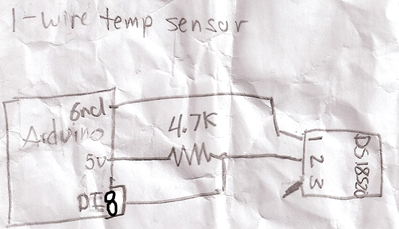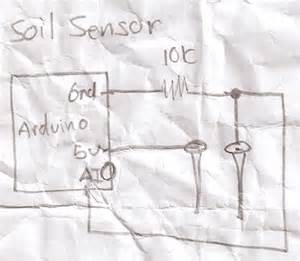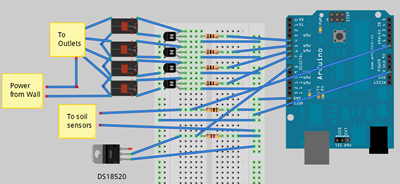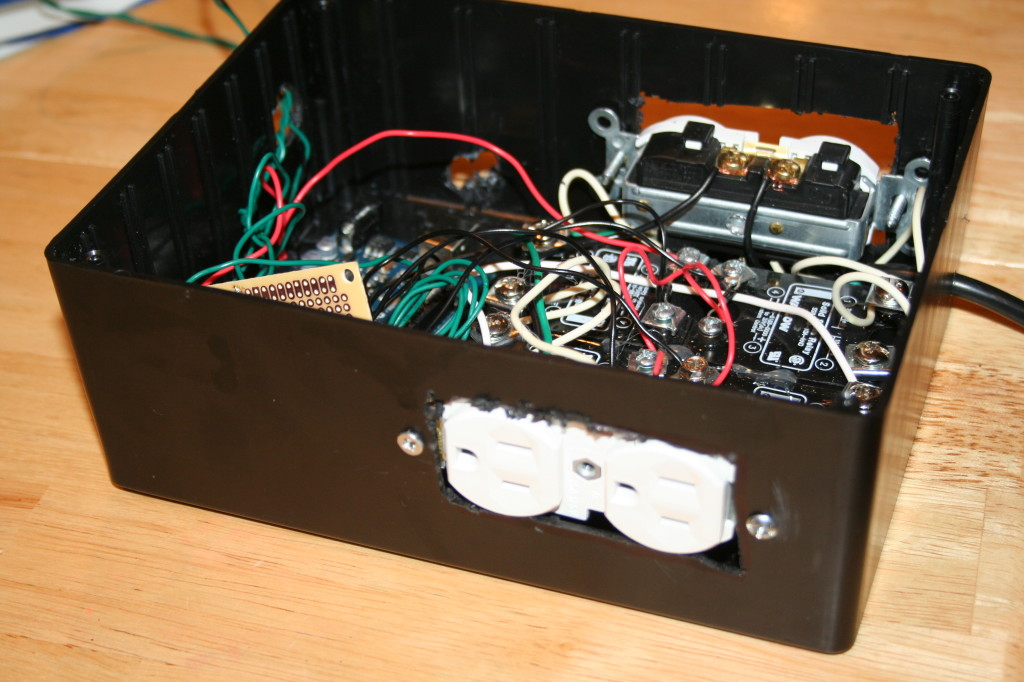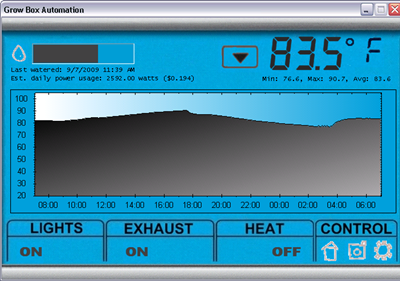5 Easy Money-saving Gardening Tips
11 years ago cheap, compost, guest post

Starting and keeping a garden is a great way to spend your time for those of you with a green thumb. I just recently took up the hobby, and was shocked at just how expensive it was to start a relatively large garden in my back yard. Undeterred by the cost, I opened my wallet, pulled out the no fee credit cards and began buying seeds, mulch, and the tools I needed to keep my garden looking great.
Make you own compost. There are two big benefits to composting. First, those scraps from the vegetables and other foods you spent your hard-earned money on don’t go to waste, allowing you to make the most of your purchases. More importantly, however, compost is free nutrient rich soil for your garden. It’s easy, too.
A very simple way to create a compost area is to choose an area of your yard that’s away from everything else and section it off with chicken wire. Once you’ve built your bin, simply toss your scraps, veggie peelings, egg shells, and more into the bin and let it decompose. Compost soil takes about a year to be ready for gardening, but once it’s ready, you’ll have some of the freshest free soil around.
Cut back on mulch. Have you laid mulch and then had pesky weeds pop up anyway? If you answered “yes,” there’s a good chance that you also purchased more mulch to lay over the invading weeds. There’s a simpler solution, however.
Next time you go to lay mulch, take some of those old newspapers out of your recycling bin and lay them flat over the area where you’re going to lay the mulch. With this biodegradable layer between the weeds and the mulch, you’ll see fewer of their little heads popping through the wood chips, and you’ll save money since you’ll have to reapply your mulch less often.
Buy self-seeding plants. Another really great way to save money on your garden going forwards is by not having to by new plants every year. Many plants – like Foxgloves, Oriental Poppies, etc. – are self-seeders. This means that as they deteriorate in the colder months, they will release seeds that will germinate when the weather gets warm again.
This is a great way to save money on your garden because it removes some of the monetary burden of purchasing all-new flowers at the start of each warm season.
Start small. One way to facilitate the lushness of your garden is to buy larger, adult plants instead of growing from seeds. Many gardening stores sell larger plants because they are more expensive to the buyer, however. To save some money this year, but smaller, starter plants or grow your garden from seeds. Seeds and smaller plants cost less because they’ve cost the growers and distributors less to grow and maintain.
For some, growing a garden can be challenging, but if you’re willing to try, going this route will save you money upfront and could very well produce just as beautiful a garden as larger plants.
Become a plant food chef. Another expense that can be very important to your garden (and its health) is purchasing plant food. Plants, like all other organisms, need certain things to thrive—water, light, nutrients, and more. And one of the ways we give plants nutrients is with expensive plant foods.
You can, however, save money on plant food by making your own. Here’s how: take compost and place it into a large container of water for a week. When the week’s up, the water should be murky and brown. That means it’s ready. Now, use this mixture to water your plants—it will work as well as store-bought foods, but will lack the chemicals found in them.
The biggest tip I can give you is to keep it small and simple until you get the hang of it. Gardening is supposed to be relaxing, not complicated. If you want complicated, try understanding section 529 college savings plans. That’s complicated. Gardening should be the opposite of that, and once you get the hang of it, it is.
Make the most of May with some quick recycling projects
11 years ago cheap, guest post, recycle

May is a great time to start enjoying the warmer weather and longer days by getting out in the garden. By taking the time to smell the roses and stroll around the allotment plot or garden you can help to combat stress levels and restore the Zen to your busy life. Discovering the plant life and wildlife using your senses will bring you closer nature. While you appreciate these little natural miracles why not give a thought to how we can help the environment at home.
While you are (hopefully) having fun in the sun you could have a go at a few recycling and repurposing activities. Here are a few tips that can help you turn your rubbish into something beautiful or functional.
1. Turn rubbish into a planter. A chipped cup and saucer, a teapot with a broken lid, a lonely wellington boot, all can be filled with compost and turned from something unloved into something beautiful. It’s true that flowers can work wonders to cheer up a dull space, all you have to do is to drill some holes in the bottom of the receptacle, fill it with compost and plant flowers or seeds. Summer bedding plants are in available at garden centers right now and can be used to add an instant impact.
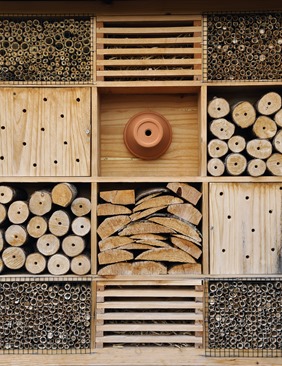
2. Build a bug hotel. These can be made from all sorts of weather durable scraps of building material and garden material. The easiest bug hotel can be made from broken garden canes which are too small for anything else. All you have to do is chop them up into similar lengths and tie them together with twine and leave it in a quiet corner of the garden. Bugs, insects and even bees will crawl in to this safe place during bad weather and frosts.
3. Make use of kitchen scraps. Slugs are a gardener’s public enemy number 1, use broken eggshells or anything prickly (holly leaves work well too) scattered around your most precious plants to deter the slimy horrible critters from munching their way through the irresistible fresh new shoots. Other kitchen scraps such a vegetable peelings can be added to the compost where they will provide valuable nutrients and help improve the structure of the soil.
4. Use finished water bottles. Empty water bottles are one of the world’s biggest recycling problems but there are so many uses for them around the garden. In May when frosts can still happen, water bottles filled with water can be used to protect courgette plants. By filling up the bottle with collected rain water and then placing the bottle (or 2 of them) next to your courgette plants you can provide extra warmth during the last frosts. The water in the bottle will warm up during the day in the sun and then cool down slower than the air at night, thus keeping your plants toasty should a frost happen. Used water bottles can also be made into slow release drip feeders which will make efficient use of water as none runs away from its intended destination.
With so many ways to recycle you need never look at your rubbish in the same way again!
This article is a guest post from Dan Whiteside, Dan blogs about DIY and gardening topics at DIY Newbie, where he discusses a variety of issues including plumbing repairs and building projects.
Protecting your transplants with window screens
11 years ago cheap, plant screen

Typically I do my best to give my plants some chance to harden off by reducing the low-end temperature of the grow box and bumping up the extended time the internal fan runs as well as letting them have a few hours out in real sun when schedule and weather permits.
Fortunately/Unfortunately eventually these plants have to venture out on their own. To provide some protection to these plants for the first few days (or extended periods of very hot weather) it is best to provide screen to allow the plants to acclimate to actual sunlight. Of course you can buy some netting screen but having a pretty small yard and even smaller garage this is something I do not want to pay for nor have to fold back up and search for again until it is needed again.
My solution is to “borrow” the window screens from a couple windows I pretty much never open (behind my desk I am typing at now) this provides a good screen with a sturdy frame which as you can see I have simple rested against a fence…though if you did not have a similar structure you easily could use a couple bamboo poles or stakes to hold the screen up.

Great part after a few days or week you simply snap them back into your window where you will easily be able to find them next year…
How to make a grow box controller
11 years ago cheap, LEDs, Uncategorized, vegetables

While my existing system was working I decided to make an upgrade to the electronics on my old grow box controller specifically to have a much more industrial strength version that will run without problems for decades to come. This version also is much safer…still probably not quite to a building code but much less worries to burning my garage down in the middle of the night. Finally it is modular if there are problems in the future I can easily switch out electronics or sensors.
Well now I have attempted to justify my reasons this is what I used to put the whole thing together:
Parts List
- Enclosure big enough to fit four Solid State Relays (SSR)
- Breadboard or custom PCB
- soldering iron and solder (optional if using breadboard)
- Arduino
- 4 – solid state relays
- 4 — 1K resistor
- 4 — 2N2222 transistor
- 4 — 1N4004 diode
- DS18S20 (1Wire temperature sensor)
- 4.7K resistor
- 10K resistor and homemade soil sensor
- 18 gauge triple stranded solid copper wire (5 feet)
- Industrial grade sockets (1 male/4 female)
- Old Ethernet cable
If we had lawyers, they probably would want us to say this:
WARNING: I am not an electrician and do not pretend to be one. I do not know the specific building electrical codes of your area, so please be sure your wiring is completed under the proper safety code for your area. As always, using high voltage electricity can result in self-electrocution or burn down your house if not done safely so if you are not comfortable doing this wiring please contact a qualified professional.
Putting it all together
On the electronics side overall the circuits are actually pretty simple and if using a breadboard definitely something that could be tackled by a beginner. Though on the other side since this project is dealing with AC current I definitely would recommend caution (no hands unless power is unplugged) or have someone a little more comfortable with 120/220V help you out.
The Brains
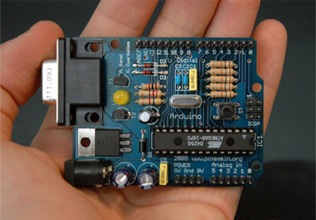
I will be the first to admit that using an Arduino for this application is complete overkill for this application but it gives plenty of room for additions in the future. For all intents and purpose you could have your grow box completely controlled from the Arduino own processing power though on my case the software and UI is more interesting part to me. For this reason the Arduino code is actually very “dumb” basically just taking commands via the build in serial through USB and setting digital outputs to HIGH/LOW or reading analog inputs.
Here is the code for your grow box controller:
1: /*
2: * GrowBox Arduino Interface
3: *
4: * Descriptions: Simple interface to digital and analog controls by passing serial inputs
5: * For example:
6: * "A1" to read analog value on pin 1
7: * "D1H" to set digital pin 1 to HIGH
8: */
9: #include <OneWire.h>
10:
11: //1-wire
12: OneWire ds(8); // on pin 8
13: #define BADTEMP -1000
14:
15: //define unique sensor serial code
16: byte temperature[8];
17:
19: #define PIN_VALUE 1 // numeric pin value (0 through 9) for digital output or analog input
18: #define ACTION_TYPE 0 // 'D' for digtal write, 'A' for analog read
20: #define DIGITAL_SET_VALUE 2 // Value to write (only used for digital, ignored for analog)
21:
22: int NUM_OF_ANALOG_READS = 2;
23: char commandString[20];
24:
25: void setup()
26: {
27: Serial.begin(9600);
28:
29: setOneWireHex();
30:
31: // Power control
32: for(int i=0; i<=7; i++)
33: {
34: pinMode(i, OUTPUT); // sets the digital pins as output
35: digitalWrite(i, LOW); // turn everything off
36: }
37: }
38:
39: void loop()
40: {
41: readStringFromSerial();
42:
43: if (commandString[ACTION_TYPE] != 0) {
44: int pinValue = commandString[PIN_VALUE] - '0'; // Convert char to int
45:
46: if(commandString[ACTION_TYPE] == 'A')
47: Serial.println(analogRead(pinValue));
48: else if(commandString[ACTION_TYPE] == 'D') {
49: if(commandString[DIGITAL_SET_VALUE] == 'H')
50: digitalWrite(pinValue, HIGH);
51: else if(commandString[DIGITAL_SET_VALUE] == 'L')
52: digitalWrite(pinValue, LOW);
53:
54: Serial.println("OK");
55: }
56: else if(commandString[ACTION_TYPE] == 'T') {
57: float temp = get_temp(temperature);
58:
59: Serial.print(temp);
60: Serial.println("C");
61: }
62: else if(commandString[ACTION_TYPE] == '1') {
63: printOneWireHex();
64: }
65: else if(commandString[ACTION_TYPE] == 'V') {
66: Serial.println("VERSION_1_0_0_0");
67: }
68: else if(commandString[ACTION_TYPE] == 'P') {
69: Serial.println("PONG");
70: }
71:
72: // Clean Array
73: for (int i=0; i <= 20; i++)
74: commandString[i]=0;
75: }
76:
77: delay(100); // wait a little time
78: }
79:
80:
81: void readStringFromSerial() {
82: int i = 0;
83: if(Serial.available()) {
84: while (Serial.available()) {
85: commandString[i] = Serial.read();
86: i++;
87: }
88: }
89: }
90:
91: void setOneWireHex() {
92: ds.reset_search();
93: ds.search(temperature);
94: }
95:
96: void printOneWireHex() {
97: ds.reset_search();
98: if ( !ds.search(temperature)) {
99: Serial.print("NONE\n");
100: }
101: else {
102: ds.reset_search();
103:
104: int sensor = 0;
105: while(ds.search(temperature))
106: {
107: Serial.print("S");
108: Serial.print(sensor);
109: Serial.print("=");
110: for(int i = 0; i < 8; i++) {
111: Serial.print(temperature[i], HEX);
112: Serial.print(".");
113: }
114: Serial.println();
115: }
116: }
117:
118: ds.reset_search();
119: }
120:
121: float get_temp(byte* addr)
122: {
123: byte present = 0;
124: byte i;
125: byte data[12];
126:
127: ds.reset();
128: ds.select(addr);
129: ds.write(0x44,1); // start conversion, with parasite power on at the end
130:
131: delay(1000); // maybe 750ms is enough, maybe not
132: // we might do a ds.depower() here, but the reset will take care of it.
133:
134: present = ds.reset();
135: ds.select(addr);
136: ds.write(0xBE); // Read Scratchpad
137:
138: for ( i = 0; i < 9; i++) { // we need 9 bytes
139: data[i] = ds.read();
140: }
141:
142: int temp;
143: float ftemp;
144: temp = data[0]; // load all 8 bits of the LSB
145:
146: if (data[1] > 0x80){ // sign bit set, temp is negative
147: temp = !temp + 1; //two's complement adjustment
148: temp = temp * -1; //flip value negative.
149: }
150:
151: //get hi-rez data
152: int cpc;
153: int cr = data[6];
154: cpc = data[7];
155:
156: if (cpc == 0)
157: return BADTEMP;
158:
159: temp = temp >> 1; // Truncate by dropping bit zero for hi-rez forumua
160: ftemp = temp - (float)0.25 + (cpc - cr)/(float)cpc;
161: //end hi-rez data
162: // ftemp = ((ftemp * 9) / 5.0) + 32; //C -> F
163:
164: return ftemp;
165: }
Copy and paste the above code into your Arduino software. For the code above I used the OneHire.h library which is free to use and can be downloaded from here. To be able to use this library simply copy the contents to C:\arduino\hardware\libraries\OneWire. Now you should be able to Compile (CTRL+R) and upload the code to the board (CTRL+U)
Now with the software uploaded you can send some simple serial commands via its built in USB to serial adapter to interact with it. The interface is are broken up into 1 to 4 character commands, which I will detail below
| Command | Description |
| T | Returns temperature from One Wire component |
| D4H | Sets digital pin 4 to HIGH (ON) (replace 4 for alternate pin) |
| D4L | Sets digital pin 4 to LOW (OFF) (replace 4 for alternate pin) |
| A1 | Reads analog value from pin 1 (replace 1 for alternate pin) |
| PING | Returns PONG which is used to confirmed controller is online |
| V | Returns version which is some forethought into the PC application being able to support different versions of controller software |
Using the build in serial monitor tool in Arduino.exe, my application, or you should be able to control your Arduino with this very simple command based interface
Now you can hook up some LEDs and watch them blink which is fun for a little while but if you want to add some grow box components read on….
Temperature Sensor
As you can see I have fully embraced the circuit schema on the back of a napkin idea. These are the actual diagrams I crumpled up and stuffed in my pocket with several trips to the garage for some final soldering of various joints until everything was solid.
Below is the simple circuit required to get your 1Wire temperature sensor working. I would recommend checking your documentation (if not labels on the chip) for the orientation to have 1 and 3 correct, if you have it wrong you should get some complete unrealistic number. Hook ground up to pin1 on the DS18S20 and pin 2 hooked up to the digital input pin 8 on the Arduino with 5V with a 4.7K resister in between to step down the voltage.
If everything is hooked up correctly you should get the current room temperature in Celsius by sending command “T” to your Arduino. If you prefer Fahrenheit uncomment line 162 and recompile and upload your changes, though if using my software I support both degree types and do the conversion in the the software. To make sure everything working (or just to play with your new toy) put your fingers on the chip for a couple seconds and take another measurement unless you keep your house very warm the temperature should go up a couple of degrees
Turning things on and off (Relays)
If you were smart enough to check the current requirements of your Solid State Relays (SSR) before you bought them you may be able to skip this whole circuit and simply hook the digital outputs to the 5V positive side and ground to the negative side of the SSR.
Unfortunately if you are like me and bought some SSRs that require more current draw than the Arduino (or any other IC chip) of 40mA then you will need to create the simple circuit below.
Basic idea is pretty simple, you are using the output from the digital pins to switch of the transistor which then allows the ground to complete the circuit with the thus turning on the relay. As you can see there is a 1K resistor between the base (middle pin) of the transistor. If you are not using a SSR relay (though recommend you do) you should add a 1N4004 diode between the positive/negative which protects the transistor from being damaged in case of a high voltage spike which can occur for a fraction of a second when the transistor switched off, this is also known as a back-EMF diode or fly back diode.
Now here you have a couple options. If you are confident of our wiring skills you can do like I did and take a couple of sockets and hook up the neutral and ground in parallel. Two save space and since I really didn’t need two separate plug-ins (nor its own plug) for each relay I removed the little metal bar between the two sockets so they could be switched on independently. Now simply hook up hot to the left side of all your relays in parallel and then connect a wire from the right side of the relay to its own plug on the two sockets.
Now a less wiring intensive method is to simply take a 6 foot (small if you can find them) and cut the hot wire (usually the one with non-smooth wire) and attach each end of the wire to both sides of the relay.
Moisture Sensor
When it comes to a moisture sensor there are a few options. First is the classic two galvanized nails, second is the cheap gypsum soil moisture sensor which I have written up in the provided link.
If you are using the other options you will need the simple circuit below. Technically it is a voltage divider, but that doesn’t really matter. Just hook up one end of your sensor to 5V and other sensor to ground with 10K resistor and also connected to analog pin 0.
My custom PCB solution

I actually started the work to create my own PCB at least a few years back. Played with if it off and on and finally pulled the trigger to get some boards printed up which I must say was very rewarding and pretty fun experience for just $20-30 of out of pocket cost. This provides all the circuits I mention above with a bonus circuit to let me know when my water reservoir is running low. I also installed a Ethernet socket not
I designed this to be an Ardunio which plugs directly on top of the Arduino. In theory I could stack more functionality on top of if but haven’t though of anything cool to do here yet.
Don’t want to spend 10-20 hours creating your own PCB and then wait 2-3 weeks for it to arrive from Hong Kong? Well you can do the same thing with a bread board which I show below.
Virtual breadboard layout
If you are new to soldering or have no interest in learning I would definitely recommend this option. Simply place the components in the holes and make connections with 18 gauge solid copper wire. You should be able to pick a small breadboard for less than $7.
Various applications
Of course for my application, I am using this to integrate with my custom software solution to control my grow box. Specifically soil sensor, temperature measurement, heater, lights, exhaust fan, and water pump. So using the circuit mentioned above I ran the hot wire through each SSR with the remaining wires connected to the plug and eventually gets plugged into the wall. Then simply hooked up the wire from the Ethernet cables to the low voltage side to turn the switches on/off. So I would say this is a bit of an improvement over my last attempt…
Before
After

Last I hooked the arduino up to my PC and used my custom software to control the temperature, water, and provide cool graphs as you can see below.
Sometimes life can get busy and you have limited time to keep an eye on your plants, for these times I also integrated with a custom Windows Phone 8 application which allows me to check the current state of the grow box using life tiles, water remotely (turn on/off lights/heater/fan as well), or even check out a current feed inside the grow box.





Looks at the actual actual grow box…
Tags: arduino, cheap, coffee grounds, grow lights, growbox, led, vegetables
How To Make A Tire Planter
11.1 years ago cheap, container garden, DIY, guest post, planter, tires

Used tires are a difficult waste product to dispose of as they take up a great deal of space and are discarded in large volumes every year. Through recycling a tire and turning it into a planter, you create something useful and attractive for your outside space for free and help the environment at the same time by keeping the tire out of landfill.
Try asking at your local garage or a breakers yard for unwanted tires, business owners are usually only too happy to give them to you as they normally have to pay to have them taken away. For this reason they are often dumped illegally by unscrupulous people.
If you want ‘how to’ videos then head for YouTube and you will find plenty but if you follow these step-by-step instructions then you will get the hang of this wonderfully simple and fun project in very little time.
First up you will need:
- An old tire or tires
- Box cutter knife
- Leather work gloves (for cutting)
- Chalk
- Paint (weather resistant)
- Soil & some compost
- Whatever you want to plant – flowers, vegetables etc
- Old clothes – tires are dirty!
- Elbow grease!
How to do it:
1. Find some used tires. Car tires are the easiest to get hold of and use for this, but if you have the space, you could use larger tires from a lorry or tractor. Create tall planters by stacking the tires to achieve the desired height.
2. Wash well with a degreaser and leave to dry. Old tires are usually quite oily and in need of a good scrub. This prepares the surface for painting and ensures adhesion.
3. (This step is optional). If you wish to open up the top of your tyre for extra planting space, remove one of the side walls using a sharp knife. With a little elbow grease and a very strong, sharp blade you can cut through and remove the side of the tire. Mark a guideline to follow using white chalk. Take care and wear a pair of leather gloves for added protection. If you will be stacking your tires, only cut the one that will be placed at the top, as the lower ones will need both sides in place to hold their shape. Lorry & tractor tires are much thicker so cutting them requires a powered grinder (or leave them as they are – much easier!)
4. Get creative! – Paint your tire using an oil based exterior (weather resistant) paint. Bright colors make a great impact in a contemporary space, or you could simply use white. If you are feeling adventurous though there is nothing to stop you painting polka dots, stripes, a pattern or whatever you like!
5. Leave the paint to dry fully. Have a rest!
6. Position your planter and fill it with soil and a bit of compost. Prepare for planting.
7. Plant up. Flowers, vegetables, herbs, strawberries, a tree or an architectural feature plant, the possibilities are endless. A stack of tires makes an excellent potato tower, as you can produce a large crop easily using minimal space. Once ready, simply knock your tower over and retrieve your crop. (You may wish to line your tire with plastic to prevent the possibility of any chemicals leaching into edible plants).
8. Sit back and enjoy your planter. Your new tire planter will last for years as it is made from an incredibly durable, weather resistant material. You have created something beautiful and practical and aside from your time and any paint you may have purchased, you project is both environmentally friendly, fun to make and free!
ABOUT THE AUTHOR
Felix is a member of the evergreenhedging.co.uk team. We are part of Greenshutters Nurseries & Garden Centre based near Taunton in Somerset which was established in 1980.
How to make a pea trellis tower
11.1 years ago cheap, peas, planter, tomato, trellis
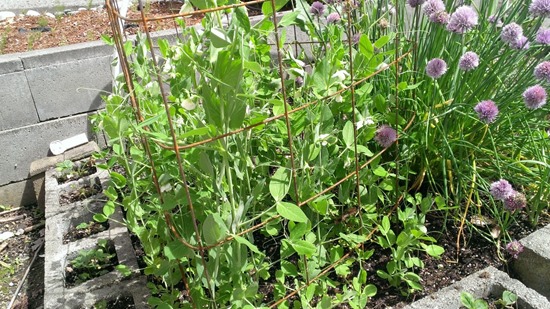
Long time readers know this is not the my first attempt at making a sturdy pea trellis I have had posts and posts about this in the past. Though those creations were a bit cheaper than my current version this one will not be falling down no matter how big those plants get.
First I started with a 4 foot by 8 foot cattle panel which ran me about $6 at Home Depot.

Given the panel had sharp edges and my largest vehicle is a pretty new minivan with leather seats I planned ahead and started the construction in the Home Depot parking lot. Taking a piece of scrap lumber I placed it on the 5th cross section on one side and bent it up until it was perpendicular to the ground then repeated with the other side.

The I carefully placed the bent panel into my minivan and brought it home for the remaining construction which pretty much was adding a zip tie in the middle to make a isosceles triangle and then tucked both ends to interweave with the other open side of the tower.

Next I used some pliers to not have as many sharp pointy parts for my kids…probably more likely me to poke myself with and also filed down any ends that seemed overly sharp.

So I had a bit of a strategy for planting the peas, to know where to plant I placed my tower in the desired spot and wiggles it around to make and outline to plant my peas. I removed it as you can see below and planted two rows of peas inside the perimeter. Then in a few weeks I will plant peas on the outside of the tower. The idea is the peas will grow and climb up the tower and have sunlight and adequate airflow to thrive. Then the second crop will start to grow but by the time it starts to disturb the inside crop they will already be harvested.

I also planted peas on the outside of the tower now on the northern facing side of the tower since it wouldn’t get much sunlight after the interior had a head start.

I know a few of you are probably thinking, “Wow this is awesome for peas, but I bet this would make an real sturdy tomato tower and way better than the ones I can buy in the garden center.” Which I would have to agree with you on that one large enough to provide good airflow and sturdy enough to support and fairly large tomato plant.

